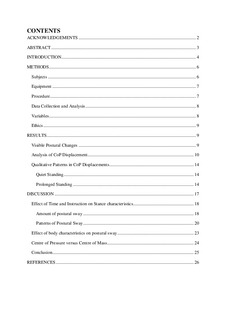Effect of standing time and instruction on stance characteristic.
Master thesis
Permanent lenke
http://hdl.handle.net/11250/271477Utgivelsesdato
2010Metadata
Vis full innførselSamlinger
Sammendrag
Aim: The aim of this study was to investigate the effect of standing time and instruction on stance characteristic by describing and comparing quiet and prolonged standing.
Methods: Two conditions were tested – Quiet Standing (QS) for 1 min (4 trials) and Prolonged Standing (PS) for 30 min (1 trial). Data were collected with an AMTI force plate and a video camera. Centre of Pressure (CoP) and its SD, RMS, and area were calculated in Matlab and SPSS was used for statistical analysis.
Results: The QS trials did not significantly differ from each other on any of the variables, but the PS trial was significantly different from all QS trials. QS was characterized by a relatively stable position of CoP throughout the trial while PS was characterized by relatively stable periods interspersed with periods with larger CoP movements. In contrast to QS, CoP patterns such as shifts, drifts, and fidgets appeared in PS. Both multi-region and single-region standing appeared in PS, whereas QS was characterized by single-region standing. There were anthropometrical differences between the two groups. Further the multi-region group had significantly more sway during the QS than the single-region group.
Conclusion: The results from the present study indicate that standing time and instruction have an effect on stance characteristics. Variables traditionally used to study quiet standing were able to confirm that quiet and prolonged standing are significantly different, but failed to describe the respective characteristics in sufficient detail. Evaluation of sway patterns and anthropometrics revealed a possible connection between stance strategy in prolonged and quiet standing.
Key words: quiet standing, prolonged standing, postural sway, centre of pressure, centre of mass, shifts, drifts, fidgets, multi-region, single-region, anthropometrics.
